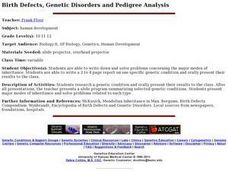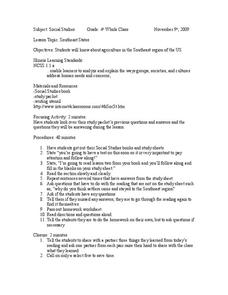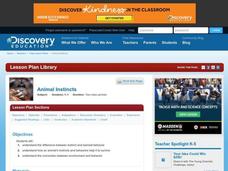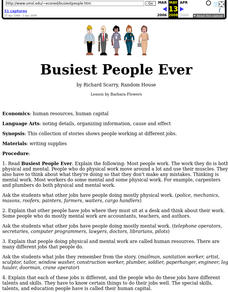Curated OER
Birth Defects, Genetic Disorders and Pedigree Analysis
Students write down and solve problems concerning the major modes of inheritance. They research a genetic condition and orally present their results to the class.
Curated OER
Taking Care of a Baby
Students are introduced to the basics of human development and the critical role of parents in taking care of a newborn.
Curated OER
Human Behavior
Students are introduced to the study of human behavior and develop their ideas about the importance of understanding mental health.
Curated OER
Mental Health 3: Mental Health Through Literature
Students examine the impact and portrayal of mental illness in literature. They develop thier ideas about mental health through the arts in this the third lesson on mental health.
Curated OER
Development
In this psychology worksheet, students complete 5 short answer questions on human's developmental stages and Kohlberg's theory.
Curated OER
Southeast States
Fourth graders acquire knowledge about the settlement of the southeast region of the United states. In this united states geography lesson, 4th graders learn to analyze and understand the ways in which groups in society have marked...
Curated OER
Animal Instincts
Students compare animal adaptations to human behavior. In this science lesson, students discuss animal instincts vs. learned behavior. Options for student writing, drawing and research are incorporated into this lesson plan
Curated OER
Biology Needs
In this life needs worksheet, students tick the box that is true about the needs for plants, animals, and humans. Students then write about the information.
Curated OER
If You Mess With A Wetland, At Least Try to Make Amends!
Eighth graders examine the role of wetlands in an ecosystem. In groups, they use the internet to research how humans have disturbed and ruined the effectiveness of wetlands throughout the country. They pretend they are in charge of...
Curated OER
What Do We Have In Common?
Seventh graders perform a dissection on a mussels and label their internal organs. In groups, they compare and contrast the mussels structure to those of human beings. They also review the functions that are necessary for survival and...
Curated OER
Global Awareness
High schoolers read about how scientists are arriving at current theories of human origin and migration through mitochondrial DNA analysis. They then piece together a map showing the data from mitochondrial DNA analysis to plot the...
Curated OER
World Population
Young scholars examine the world population data using MyWorld GIS software and compare and contrast the population characteristics of countries around the world. Students summarize their findings in a report.
Curated OER
Economics: Who Benefits from Competition?
Students examine competitive markets and complete a simulation called "The More. the Merrier." In the simulation they assess how goods are more available when competition increases. Students investigate how competition and the opening of...
Curated OER
Local Area - Is the Land Connected to Us?#144
Students examine how human influences have affected the Connecticut River Valley. They determine what a region is in relation to its human influences. They label the important human features of this region including dams, canals, and...
Curated OER
Great North
Students view a video about the Arctic Circle, North Pole and Northern Europe. They locate areas using a map. They create a drawing of the countries where the Inuit live.
Curated OER
Great North
Students use maps to locate the Arctic Circle, the North Pole and Northern Europe. They draw and label countries within the Arctic Cirlce and identify the groups of people who live there. They also watch and answer questions about the...
Curated OER
Hominid Series
Young scholars are introduced to the human stages of evolution. They complete a series of lessons on identifying the cranial structure for various hominids, understanding the timeline involved in human evolution and investigating ancient...
Curated OER
Why Do People Go to School?
Learners investigate data on how one's level of education effects earning potential. They define the associated vocabulary.
Curated OER
OBSERVING THE ROLES OF MALES AND FEMALES IN THE NURTURING OF THE YOUNG THROUGHOUT THE ANIMAL KINGDOM
Students watch animal videos to identify and compare the male/female roles of different species of animals. They draw conclusions and compare those roles to those of humans. They discuss how the human male/female roles have changed...
Curated OER
Investigating Human Behavior
Students explore the Holocaust and themes such as prejudice and discrimination.
Curated OER
Why Behaviors Differ
Students watch a PowerPoint presentation and fill out a worksheet to explore the different abilities of students aged two months to four years.
Curated OER
Busiest People Ever
Students write a paragraph about what they want to do when they grow up. They include the special skills and education (human capital) they must have to do the job they've chosen.
Natural History Museum
Natural History Museum: Mammals
This is the opening page for an online exhibit on mammals. The topics covered in this exhibit include whales, dolphins, bats, humans, chimps, and more.
Seeker
Seeker: Human Like Hands Came Before Actual Humans
Article reports on how the human hand has evolved. Includes a video.

























